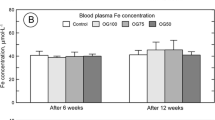Abstract
To elucidate compositional changes of the ligament with aging, the authors investigated age-related changes of elements in the ligamentum capitis femoris (LCF) of monkeys with a wide range of ages by direct chemical analysis. Used rhesus and Japanese monkeys consisted of 9 males and 22 females, ranging in age from newborn to 31 years (average age = 10.4 ± 10.9 years). After incineration with nitric acid and perchloric acid, element contents were determined by inductively coupled plasma-atomic emission spectrometry. It was found that the P content decreased significantly in the LCFs of monkeys with aging, but other six element contents, Ca, S, Mg, Zn, Fe, and Na, did not change significantly with aging. Assuming that the P content indicated the active cell density and the S content indicated the protein amount, an age-related change of the mass ratio of P/S was examined in the LCFs. The mass ratio of P/S decreased significantly in the LCFs in childhood. Regarding the relationships among elements, significant direct correlations were found among the Ca, P, S, and Mg contents in the LCFs. It was suggested that the active cell density of the connective tissue cells might decrease significantly in the LCF in childhood.




Similar content being viewed by others
References
Tohno Y, Tohno S, Laleva L etal (2008) Age-related changes of elements in the coronary arteries of monkeys in comparison with those of humans. Biol Trace Elem Res 125:141–153
Menetti F, Tohno S, Tohno Y etal (2005) Age-dependent decreases of calcium, phosphorus, sulfur, and zinc in the cardiac valves of monkeys. Biol Trace Elem Res 106:231–245
Tohno S, Tohno Y, Azuma C etal (2006) Decreases of calcium and phosphorus in monkey cardiac walls with development and aging. Biol Trace Elem Res 110:233–249
Satoh H, Tohno S, Azuma C etal (2005) Age-related attenuation in the elements in monkey sino-atrial node. Biol Trace Elem Res 107:43–51
Tohno Y, Tohno S, Satoh H etal (2011) Gender differences in the phosphorus content of the sino-atrial nodes and other cardiac regions of monkeys. Biol Trace Elem Res 143:871–881
Tohno Y, Suwannahoy P, Tohno S etal (2010) Age-related changes of elements in the tendons of the peroneus longus muscle in Thai, Japanese, and monkeys. Biol Trace Elem Res 133:291–303
Tohno Y, Moriwake Y, Takano Y etal (1999) Age-related changes of elements in human anterior cruciate ligaments and ligamenta capitum femorum. Biol Trace Elem Res 68:181–192
Fritsch H, Hegemann L (1991) Development of the ligamentum capitis femoris and the artery with the same name. Z Orthop Ihre Grenzgeb 129:447–452
Tohno Y, Tohno S, Minami T etal (1996) Age-related changes of mineral contents in human thoracic aorta and in the cerebral artery. Biol Trace Elem Res 54:23–31
Fraustra da Silva JJR, Williams RJP (1991) The biological chemistry of the elements. Clarendon, Oxford
Oster O, Dahm M, Oelert H etal (1989) Concentrations of some trace elements (Se, Zn, Cu, Fe, Mg, K) in blood and heart tissue of patients with coronary heart disease. Clin Chem 35:851–856
Kadler KE, Holmes DF, Trotter JA etal (1996) Collagen fibril formation. Biochem J 316:1–11
Ippolito E, Natali PG, Postacchini F etal (1980) Morphological, immunochemical, and biochemical study of rabbit Achilles tendon at various ages. J Bone Joint Surg 62-A:583–598
Williams RW, Rakic P (1988) Elimination of neurons from the rhesus monkey’s lateral geniculate nucleus during development. J Comp Neurol 272:424–436
LaMantia AS, Rakic P (1990) Axon overproduction and elimination in the corpus callosum of the developing rhesus monkey. J Neurosci 10:2156–2175
Landis WJ, Librizzi JJ, Dunn MG etal (1995) A study of the relationship between mineral content and mechanical properties of turkey gastrocnemius tendon. J Bone Miner Res 10:859–867
Utsumi M, Azuma C, Tohno S etal (2005) Increases of calcium and magnesium and decrease of iron in human posterior longitudinal ligaments of the cervical spine with aging. Biol Trace Elem Res 103:217–227
Tohno Y, Tohno S, Taniguchi A etal (2012) Characteristics of the three ligaments of human spring ligament complex from a viewpoint of elements. Biol Trace Elem Res 146:293–301
Shinohara Y, Kumai T, Higashiyama I etal (2013) Histological and molecular characterization of the femoral attachment of the human ligamentum capitis femoris. Scand J Med Sci Sports. doi:10.1111/sms.12155
Acknowledgments
This work was supported by the Cooperation Research Program (2005–2009) of Primate Research Institute, Kyoto University.
Author information
Authors and Affiliations
Corresponding author
Rights and permissions
About this article
Cite this article
Tohno, Y., Tohno, S., Oishi, T. et al. Age-Related Decrease of the Phosphorus Content in the Ligamentum Capitis Femoris of Monkeys. Biol Trace Elem Res 161, 78–84 (2014). https://doi.org/10.1007/s12011-014-0074-9
Received:
Accepted:
Published:
Issue Date:
DOI: https://doi.org/10.1007/s12011-014-0074-9




